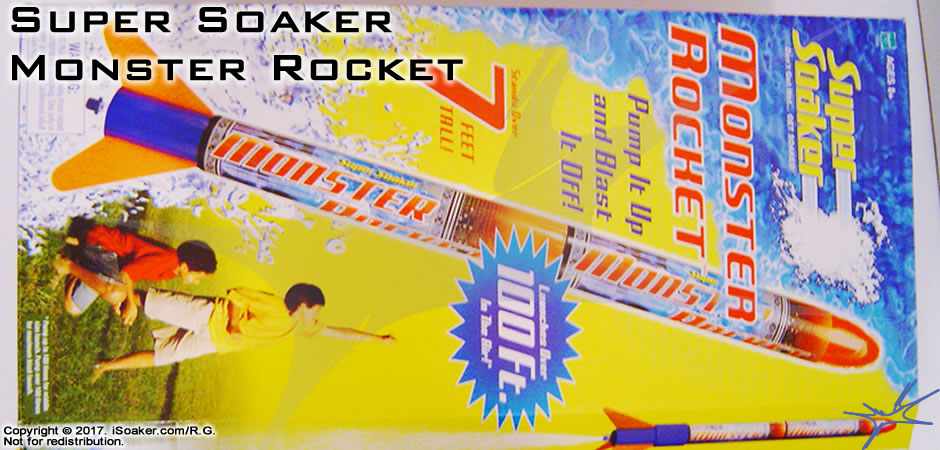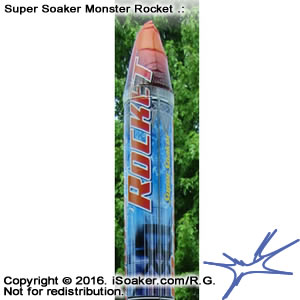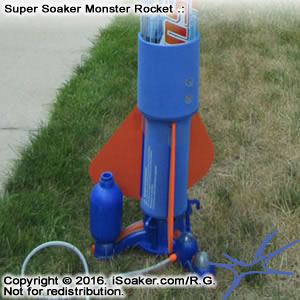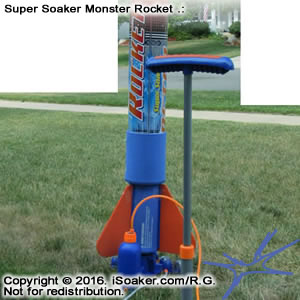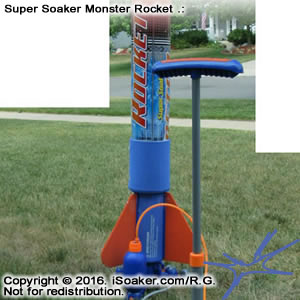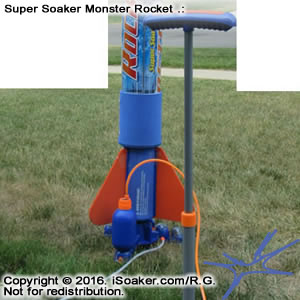
 :: Super Soaker Monster Rocket
:: Super Soaker Monster Rocket
.: No notable statistics currently available
Manufacturer: Hasbro Inc.
Class: Novelty
Item Number:
Copyright Date / Release Date: 2003 / 2004
Patents:
Availability: No Longer Made
Basic Statistics ::
Weight: 0.00 g (0 oz.)
Reservoir Volume: 0.00 mL (0 fl.oz.)
Pressure Chamber Volume: N/A
Pump Volume: N/A
iSoaker.com Ratings .:
Power: N/A


Range: N/A


Encumbrance: N/A


Ergonomics: N/A


Capacity: N/A


Overall: N/A


Blaster Dimensions :: N/A x N/A x N/A
Version Colours .:
Body
Reservoir
Pressure Chamber
Detailing
Notes
1 ::
2 ::
Nozzle Information: 1 (propulsion) .:
Range (level)
Range (45°)
Output
iSoaker Output Rating
iSoaker Power Rating
Shot Time
Main ::
N/A
N/A
N/A
N/A
N/A
N/A
Notes:
- Most statistics are from models tested by iSoaker.com; individual performance may vary; some models exhibit greater variability than others (i.e. output, range, colours, etc.)
- Please reference iSoaker.com if you use any information from any part of this website.
Own this product?
Submit a Review Online
Compare Products
Product Comparison Page
IMPORTANT NOTE: On September 9, 2004, this Product, the Super Soaker Monster Rocket, was recalled by the US Government Consumer Product Safety Commission. See: Super Soaker Monster Rocket recall.
A working Super Soaker Monster Rocket is available for review at iSoaker.com and has been tested, albeit nearly 12 years after its initial acquisition. In general, the Super Soaker Monster Rocket is a large, inflatable water-powered rocket that blasts into the air thanks to the force of water being expelled from its pressure chamber. Unfortunately, this product has been recalled by Hasbro due to design issues of caps detaching forcefully as well as rockets landing more forcefully on users. From our limited testing, there is indeed a danger of this item falling forcefully onto someone if they are not paying attention.
The Rocket .:
There are two distinct parts of the Super Soaker Monster Rocket: (1) the upper portion (fuselage) is a mylar-type rocket-shaped balloon and (2) the lower portion of the rocket comprised of the plastic bottle/pressure chamber, foam housing, and foam fins. The more-than-6-foot tall balloon is filled through an air valve located near the nose cone of the rocket. Due to the size of the rocket, a pump is highly recommended in order to fill it. A clear rubberize plastic band is supposed to be placed around the upper portion of the rocket to act as a counter-weight, though the usefulness of this counter-weight is rather debatable. This balloon-based fuselage is then inserted into the lower portion of the rocket, held in place primarily by friction.
The base of the rocket contains the pressure chamber surrounded by some stiff foam. Plastic guides are positioned roughly 120 degrees apart around the base of the rocket and serve as the attachment point for the Monster Rocket's foam fins. Due to the age of the fins, the glue/adhesive holding part of them together had gone brittle, but the tabs were repaired using some packing tape. Presumably this would not be a problem for a new item, but the one tested had been sitting around for ~12 years.
The Launcher (Base).:
The base/launcher for the Super Soaker Monster Rocket is made up of five parts: (2) ground stakes, (1) air pump, (1) central base piece, and (1) third leg. The third leg must be attached to make the base complete as was likely only separated from the central base in order for the base to fit within the already fairly large box. Two (2) ground stakes thread through holes in the central base piece to help anchor the base to the ground and serves to prevent this ~7 foot tall rocket from making the base fall over when on. Also on the central base is a ball-bearing based leveler, the water reservoir, and the squeeze-bulb-based launch trigger. The air pump is attached to the base, the end of its tubing being screwed into the top of the base's water reservoir. On the pump, itself, it a pressure level indicator whose needle begins moving once enough air pressure is built up within the Monster Rocket's pressure chamber.
Launching the Rocket .:
Once the rocket portion is fully inflated and assembled and the base is assembled, launching it requires following a general series of steps:
- Place the base on a flat area of ground and insert the two stakes to help further stabilize the base; to ensure the base is level, the ball bearing in the leveling gauge should be centered and resting over the small hole in the middle of the gauge;
- insert the bottom/bottle opening of the rocket into the top-side, center opening of the base until it clicks
- Fill the blue bottle reservoir with water (it is unclear whether the 2/3-3/4 full rule for filling the pressurized reservoir needs to be followed, but it doesn't hurt not to overfill; of course, underfilling will mean there is not enough water to achieve a good launch
- Securely attach the threaded-cap-side of the air pump's hose to the top of the blue reservoir; ensure the cap is tightened enough to prevent air from escaping, but not too tight that the seal may be damaged;
- Before pumping, ensure the blue squeeze bulb is brought over beside the pump and that both the bulb and the pump are away as far as possible from the base, but without over-stressing the tubing;
- Use the pump to push air into the blue reservoir; the instructions suggest that it may take more than 100 pumps to produce enough pressure; one knows the rocket is truly being pressurized upon hearing a secondary valve opening after several pumps combined with the sound of water rushing into the bottle-portion of the rocket (thanks to the clear plastic used for the bottle, water should also then be visible through the plastic);
- Keep an eye on the pressure gauge level on the pump as indicated by a yellow pointer on the gauge (at present, it is unclear how consistent a particular level on the pressure gauge relates to the height/distance that the rocket will launch);
- Once the preferred level of pressure is reached, stop pumping, ensure no one is beside the rocket (or approaching it)
- To launch, the blue squeeze bulb must be squeezed quickly and forcefully enough to activate an internal valve, releasing the rocket and allowing pressurized water to push out from the opening at the base of the rocket; the force of water pushing downward thrusts the body of the rocket upwards, spraying those by the base with a bit of water and mist
- Keep at eye on the rocket to ensure it is not falling on anyone/anything and giving any unsuspecting bystanders enough warning to move out of the way.
From doing a few simple field tests, the dangers of this item became readily apparent. While the rocket, itself, is not particularly heavy, there is one instance where a short flight resulted in the rocket more-or-less doing a full vertical drop downwards, accelerating rather quickly and hitting the ground with enough force to dent the bottle-portion. Had the rocket hit someone's head, it would have undoubtedly hurt significantly. Because of this, a higher launch was never attmpted.
Overall ::
The Super Soaker Monster Rocket should have made for a great, fun toy, but due to problems both with the launcher (no way to tell if the reservoir is still pressurized and no way to even depressurize it easily) as well as the rocket portion (relies on an unreliable method of downward deceleration which, when it fails, results in a reasonably heavy object falling from a good height), While it could have been a great item, the dangers of its use make its recall fully warranted.
Pros
Massive, impressive water powered rocket, able to launch quite high
Cons
*** IMPORTANT *** On September 9, 2004, this Product, the Super Soaker Monster Rocket, was recalled by the US Government Consumer Product Safety Commission. See: Super Soaker Monster Rocket recall. Due to its size, weight, and unreliable method for returning to the ground, the falling rocket poses a danger to anyone on the ground near its landing site. The reservoir also ends up pressurized with no easy way to depressurize to refill which can lead to the reservoir's cap shooting off at one's face/eyes. There should have been an additional pressure indicator as well as relief valve.
Images .:
Related Content .:
Product Listing Page | Super Soaker Product Evolution Tree
Additional Resources
Water Blaster: Basics | Care, Cleaning, and Storage | Soaker Use: Basics|Repair Articles|Pressurized Reservoir Tech Troubleshooting
Product Listing | Colour Listing | Series Listing | Product Comparison
Repair Guide | Tech Research | Timeline | The Armoury Gallery | Usage Tips









